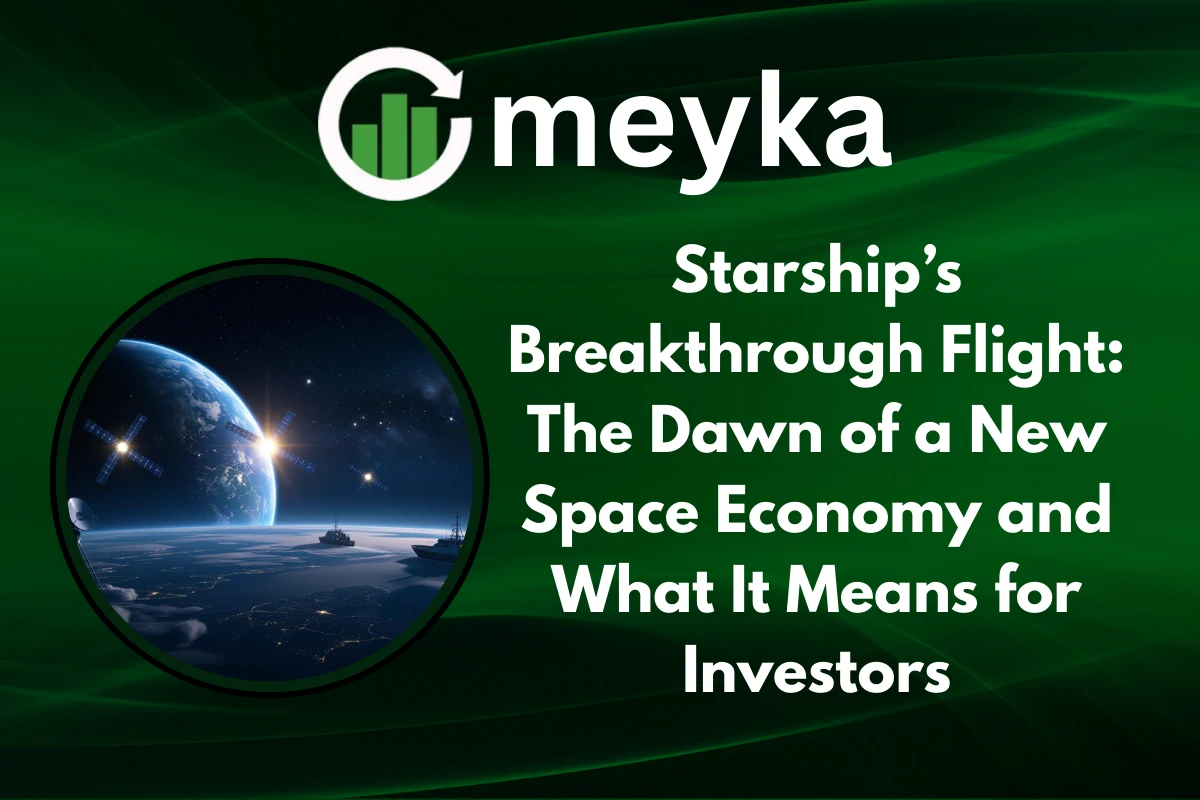Starship’s Breakthrough Flight: The Dawn of a New Space Economy and What It Means for Investors
Key Takeaways
- SpaceX’s Starship breakthrough flight marks a turning point for the Space Economy, proving large-scale reusability and lowering launch costs.
- The mission strengthens Starlink expansion, orbital manufacturing, and global broadband markets, creating trillion-dollar opportunities for investors.
- Governments and private firms see Starship as a strategic asset, boosting partnerships, contracts, and competition in the global space race.
- Despite risks like heat shield challenges, regulations, and competition, analysts project the Space Economy could reach $1–3 trillion by 2040.
In what many are calling a historic milestone, SpaceX’s Starship breakthrough flight is not just a success for rocket science but also a game-changer for the global Space Economy. This mission has reshaped how experts, governments, and investors view the future of space exploration, broadband markets, and commercial industries tied to orbit.
With a successful test of the world’s most powerful rocket, the next stage of growth could fuel trillions of dollars in economic value.
Why Is Starship’s Flight So Important for the Space Economy?
The Space Economy has been growing rapidly over the last decade, but access to orbit has always been the biggest cost barrier. Starship’s near-perfect flight changes that narrative by proving that large-scale, reusable rockets can launch more payloads for much lower costs.
According to AInvest, the cost per launch could fall dramatically, enabling not just satellite companies but also energy, manufacturing, and even tourism firms to access space affordably. When the cost to orbit drops from hundreds of millions to just a few million dollars, the Space Economy shifts from a government-led effort to a truly commercial industry.
But what does this really mean for investors?
How Does Reusability Drive Investor Confidence?
Traditional rockets are used once and discarded, but Starship is designed for full reusability. The latest test flight showed both the booster and spacecraft reaching controlled splashdowns, proving the model works.
For investors, this means predictable costs, scalable launch cycles, and better margins. Analysts predict that if SpaceX achieves its goals, launches could cost as little as $10 million per flight. This makes satellite deployment, orbital infrastructure, and deep-space missions financially viable for private firms.
Investors are asking: Could the Space Economy become as profitable as the internet boom?
Starlink, Broadband, and the Commercial Space Push
One of the clearest benefits of Starship’s success is the expansion of Starlink, SpaceX’s satellite internet business. With Starship able to carry dozens of satellites at once, Starlink can scale faster than ever. This is important because global broadband demand is expected to grow into a multi-trillion-dollar sector.
The AInvest report highlights how faster deployment of Starlink not only drives revenues for SpaceX but also lowers internet costs for remote regions worldwide. In this way, the Space Economy touches daily life on Earth, making connectivity more affordable and accessible.
Could this be the first time investors see satellite broadband as a mainstream market?
What Does This Mean for the Future of Space Manufacturing?
Space is not just about satellites. With cheaper and frequent launches, companies can test new opportunities such as orbital manufacturing, 3D printing in microgravity, and even producing pharmaceuticals that are more effective when developed in space conditions.
This sector of the Space Economy could attract billions in venture funding. Companies that once hesitated due to high costs now see Starship as the vehicle that can finally open this door. Imagine materials created in orbit and shipped back to Earth, or space-based solar power systems that deliver clean energy.
Why Are Governments Watching Closely?
The Space Economy is not only commercial, it is strategic. Governments are watching SpaceX’s Starship program closely because it changes the balance of power in the global space race.
NASA has already partnered with SpaceX to support its Artemis missions to the Moon. Other countries, such as China and India, are accelerating their programs as well. For governments, lower-cost access to orbit means more security satellites, faster exploration programs, and stronger economic influence.
From an investor’s perspective, government contracts with SpaceX provide stability and long-term revenue streams, making the Space Economy less speculative and more structured.
Investor Risks: What Could Still Go Wrong?
No breakthrough comes without risks. While Starship’s test was close to flawless, there are still challenges ahead. Heat shield damage, structural stress, and complex orbital refueling are issues that SpaceX must solve before full commercial operations begin.
For investors, the risks include regulatory delays, environmental reviews, and fierce competition from other private players. Companies like Blue Origin, Rocket Lab, and international agencies are also scaling their capabilities, which means the Space Economy will not be a one-company race.
As Investopedia notes, space investing carries high volatility, but the long-term payoff can be massive if companies like SpaceX deliver on their promises.
Social Buzz Around the Flight
The excitement around this launch spilled across social media. Elon Musk himself celebrated the mission on X (Twitter), calling it a “milestone for humanity’s journey to Mars.” Investors and analysts chimed in, noting that SpaceX’s ability to cut launch costs and expand Starlink could reshape global markets.
How Big Could the Space Economy Become?
Estimates from industry analysts suggest the Space Economy could be worth $1 trillion to $3 trillion by 2040. This includes satellite internet, space tourism, manufacturing, defense, and asteroid mining. With Starship showing practical success, these projections no longer sound like science fiction.
Investors should note that the Space Economy is not a distant dream; it is already here. Companies are raising capital, building infrastructure, and aligning with government programs. The breakthrough flight is the spark that accelerates the entire timeline.
Conclusion: The New Frontier for Investors
The Space Economy is entering a new era, and Starship’s breakthrough flight is the catalyst. For investors, the message is clear: opportunities in broadband, manufacturing, tourism, and exploration are opening faster than expected.
Risks remain, but with proven reusability and scaling capacity, SpaceX has shown the world that space can be more than exploration, it can be a thriving economy. The dawn of this new age may very well mirror the rise of the internet, creating fortunes for those who recognize the trend early.
For now, one thing is certain: the Space Economy has moved from vision to reality, and Starship’s breakthrough is the headline that marks its beginning.
FAQ’S
Yes, the space economy is seen as a strong long-term investment because of growth in satellites, broadband, and future deep-space industries.
Starship is mainly funded by SpaceX through private investors, with some contracts from NASA and government agencies.
Yes, SpaceX is privately held and backed by investors like Google, Fidelity, and major venture capital firms.
It creates opportunities in satellite internet, resource mining, global communication, and new technology innovation.
Investors believe space will power future industries like global broadband, lunar mining, and orbital manufacturing.
Currently, the U.S. leads the space economy with the largest market share and strongest government-private partnerships.
Failures are part of rapid testing, as SpaceX improves Starship’s heat shield, engines, and reusability with each flight.
Starship is developed by SpaceX, but NASA is a major partner that has contracted it for Artemis Moon missions.
Disclaimer
This is for informational purposes only and does not constitute financial advice. Always do your research.






